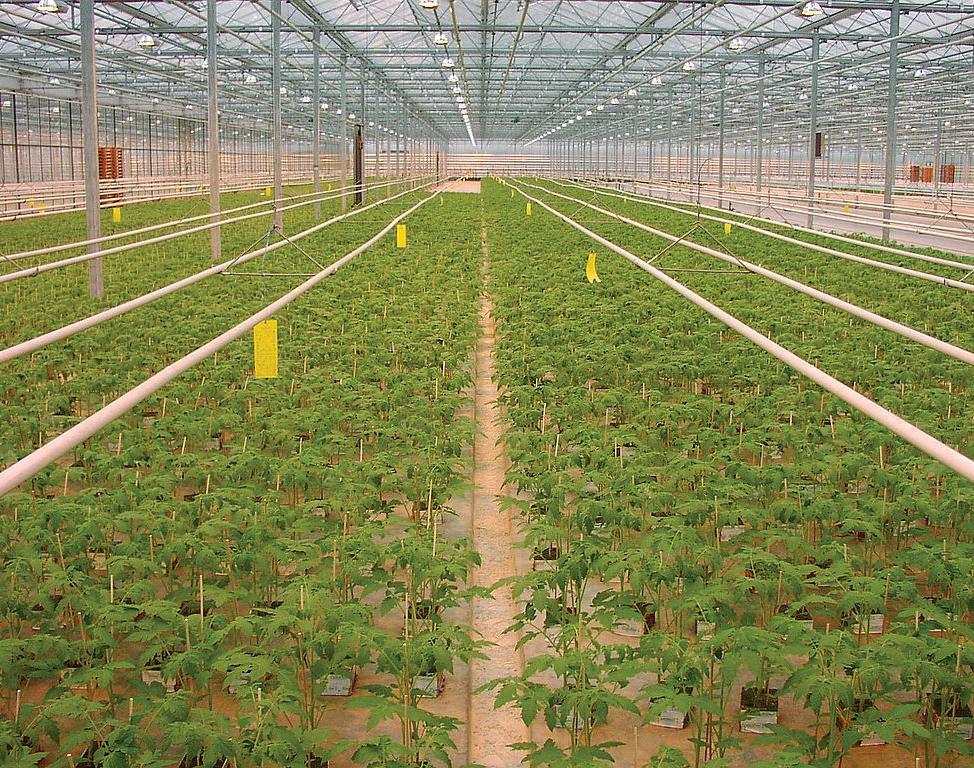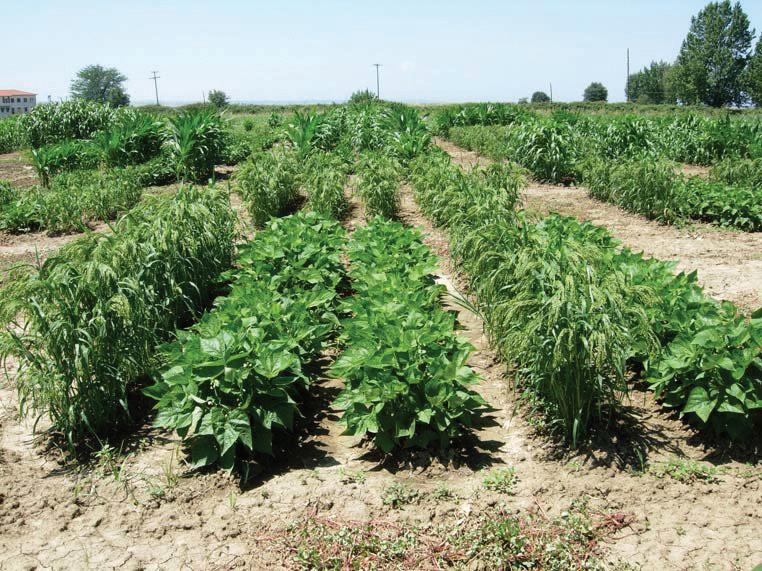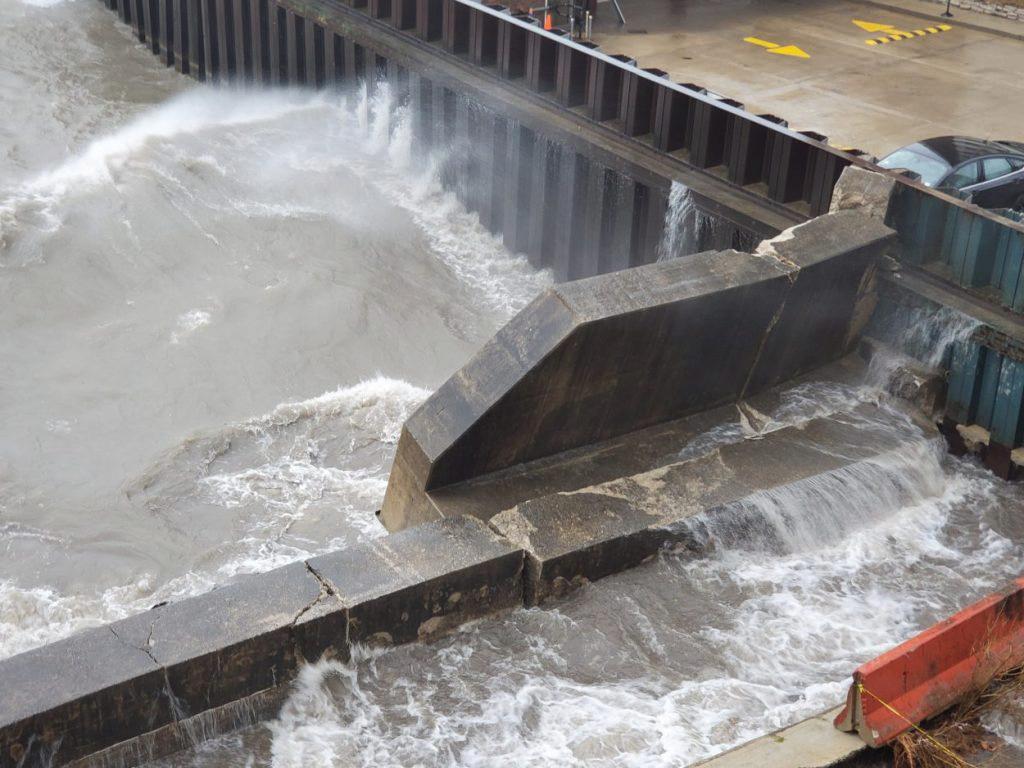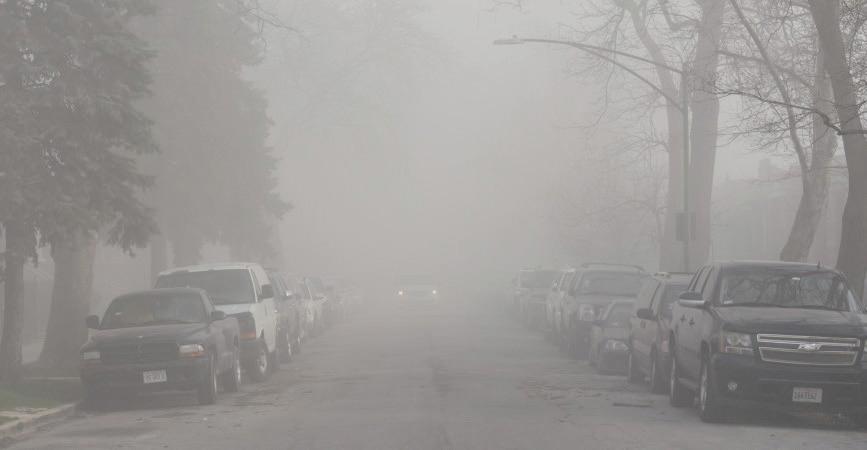
18 minute read
THE EXPANSION OF mONOCULTURE FARmING AND ITS NEGATIVE ImPACTS: IS THERE HOPE ALENA SPREITzER
If you walk into a grocery store in the U.S. today, you may see aisles filled with fresh produce. Despite this access, the population shopping in cities is largely disconnected from the agricultural systems that help to sustain their lives. Distanced from the food production process, it can be difficult to understand the magnitude of these operations and the problems large-scale farming can cause.
Over the last fifty years, population growth has put immense pressure on our agricultural systems to constantly expand. Since 1950, the human population has increased by 4 billion [1]. While the population has continued to grow exponentially, our food production rate has begun to slow [2]. This 20th century trend created concerns about the sustainability of our food systems and led many scientists to develop innovations, such as monoculture farming, to maximize production. Though the expansion of these tech-
Advertisement
niques has resulted in “an increase of our agricultural productive capacity, alleviating the problem of how to feed our large population, it has created a new environmental crisis of its own. The U.S.’s primary agricultural method is monoculture farming, a system best described as the planting of a single species of crop on the same land year after year. This method began to increase in popularity in 1910, and it reduced the time and effort required to produce crops [3]. The resulting production increase helped support the growing U.S. population. While population growth has slowed to around 1%, monoculture farming is still the predominant technique for feeding the 329 million people residing in the U.S. today [4]. In fact, 442 million acres are used for monoculture farming, which is 1/5 of the U.S.’s total land area [5].
Though monocultures are effective at mass-producing a single crop, this farming method has negative impacts on the environment. When only a single crop is grown on a given piece of land, the soil has difficulty retaining the proper mineral concentration. Over time, the soil is depleted of its nutrients and becomes less suited for farming. For example, most crops require soil rich in nitrogen in order to grow. However, only certain plants, such as soybeans, are able to fix nitrogen in the soil to replenish the stores of nitrogen. If a farm routinely plants only corn, which cannot fix nitrogen, the soil will eventually be depleted of nitrogen and nothing will be able to successfully grow [6]. In this way, monoculture farming methods can render land barren and unusable for agriculture, leading to a demand for increased farmland. Since arable land is finite, this decreases the longevity of the monoculture farming technique.
Additionally, monoculture plots require more pesticides and herbicides than a mixed culture plot does. When only one crop is grown in a given area, pests can flourish because of the bountiful food and shelter surrounding them; they thrive in the “resource-dense” setting, wreaking havoc on the crops [7]. As a result, there is a constant need to use pesticides. However, despite increases in pesticide application, there has still been a reduction in crop yield of, on average, 20-30% per year due to pests [8]. This trend demonstrates how monoculture farming not only has a negative
WHILE POPULATION GROWTH HAS SLOWED TO AROUND 1%, mONOCULTURE FARmING IS STILL THE PREDOmINANT TECHNIQUE FOR FEEDING THE 329 mILLION PEOPLE RESIDING IN THE U.S. TODAY [4]. SHOPPING IN CITIES IS LARGELY DISCONNECTED FROm THE AGRICULTURAL SYSTEmS THAT HELP TO SUSTAIN THEIR LIVES.
The application of pesticides to a field of crops.
Courtesy of Sagacious News Network
impact on the land quality but also on crop yield, a point of concern as the technique was developed explicitly to increase production due to population growth.
With a large population to sustain, it is worth considering alternatives to monoculture farming that may decrease our reliance on this unsustainable practice. For example, intercropping, a technique in which multiple crops are interspersed in the same area, helps prevent pest invasions because it increases the distance between each crop of preference and the pest populations are unlikely to proliferate across the different crops [7]. Crop rotation, the

Courtesy of Dag Endresen A typical monoculture field. This field in particular is a wheat farming plot in Lund, Sweden.
cycling of various crop varieties throughout the growing season, can also reduce the need for herbicides and pesticides by improving soil health [9].
As urbanization continues in the U.S. and globally, there is also increased interest in developing agricultural techniques tailored to urban spaces. These techniques focus on applying greenhouse technologies to maximize production in small, indoor spaces, a method that contrasts sharply with monoculture farming’s need for wide tracts of land [10]. However, the question of how to scale these solutions in order to support the size of the U.S. population remains to be answered.
Even without altering modes of production, it is possible to improve the sustainability of our food system through reduction of food waste. In the U.S., 3040% of the food supply is wasted [11]. Often this waste occurs before the food even arrives at the grocery store, but consumers also play a role in the food waste problem. In 2010, 31% of the food supply at the retailer and consumer levels was wasted, and poor manage ment by the consumer accounted for 21% of this 31% [12]. Being mindful of expiration dates and avoiding over-buying are two strategies that can help reduce this waste.
Though the U.S. remains reliant on monoculture farming, there are a number of alternative approaches emerging. Innovative farming techniques such as crop rotation, intercropping, and greenhouse agriculture are important to explore, particularly, as the global population continues to grow. For example, countries in earlier stages of industrialization tend to have more exponential population growth rates [13], meaning that increasing food production is a key area of focus. The U.S. provides an interesting case-study of both the benefits and drawbacks of adopting monoculture farming as the predominant ag-
An example of strip intercropping with broomcorn and bush beans [19].

Courtesy of Goldlocki An industrial greenhouse of tomato plants in the Netherlands. ricultural production strategy. By reflecting on this history, we can potentially build stronger, more sustainable food systems in the future, using techniques that support our increased population while minimizing damage to the environment.

References
1. Bongaarts, John. “Human population growth and the demographic transition.” The Royal Society Publishing, 27 October 2009, https://royalsocietypublishing. org/doi/full/10.1098/rstb.2009.0137. Accessed October 31, 2020.
2. “Global agriculture toward 2050.” High Level Expert Forum, 2009, http:// www.fao.org/fileadmin/templates/wsfs/ docs/Issues_papers/HLEF2050_Global_Agriculture.pdf. Accessed November 22, 2020.
3. Sylvester, Kenneth. Cunfer, Geoff. “An Unremembered Diversity: Mixed Husbandry and the American Grasslands.” Agricultural History, 2009, https:// www.ncbi.nlm.nih.gov/pmc/articles/ PMC2766303/. Accessed November 22, 2020.
4. Roser, Max; Ritchie, Hannah; Ortiz-Ospina, Esteban. “World Population Growth.” Our World in Data, 2013, https://ourworldindata.org/world-population-growth. Accessed October 31, 2020.
5. Eubanks, William S. II. “A Rotten System: Subsidizing Environmental Degradation and Poor Public Health with Our Nation’s Tax Dollars.” The United States Department of Justice. Accessed November 22, 2020.
6. Wilson, Victoria. “How the Growth of Monoculture Crops Is Destroying our Planet and Still Leaving us Hungry.” Our Green Planet, 2014, https://www. onegreenplanet.org/animalsandnature/ monoculture-crops-environment/#:~:text=Instead%20of%20rotating%20 different%20crops,to%20diminish%20 from%20the%20ground.&text=If%20 you%20do%20not%20rotate,depleted%20of%20this%20vital%20nutrient. Accessed November 22, 2020. 7. Segoli, Moran; Rosenheim, Jay A. “Should increasing the field size of monocultural crops be expected to exacerbate pest damage?” Agriculture, Ecosystems & Environment, 2012, https://www.sciencedirect.com/science/ article/pii/S0167880912000242. Accessed November 22, 2020.
8. Altieri, Miguel A. “Modern Agriculture: Ecological impacts and the possibilities for truly sustainable farming.” University of California, Berkeley, http://parrottlab.uga.edu/Tropag/ CR2010/Pre-trip%20readings/Modern%20Ag%20&%20Sustainablity--Altieri.pdf. Accessed October 31, 2020.
9. Selim, Mostafa. “A Review of Advantages, Disadvantages and Challenges of Crop Rotations.” Egyptian Journals, 2019, https://journals.ekb.eg/article_24300.html. Accessed October 31, 2020.
10. Shamshiri, R et al. “Advances in greenhouse automation and controlled environment agriculture: A transition to plant factories and urban agriculture.” International Journal of Agricultural and Biological Engineering, 2018, https://www. semanticscholar.org/paper/Advances-in-greenhouse-automation-and-controlled-A-Shamshiri-Kalantari/6f9a25f5c38d574157ff2e2d46503d6490417ca9. Accessed November 22, 2020.
11. “Food Waste FAQs.” U.S. Department of Agriculture, https://www.usda. gov/foodwaste/faqs. Accessed November 22, 2020.
12. Buzby, Jean C.; Wells, Hodan F.; Hyman, Jeffrey. “The Estimated Amount, Value, and Calories of Postharvest Food Losses at the Retail and Consumer Levels in the United States.” United States Department of Agriculture, 2014, https:// www.ers.usda.gov/webdocs/publications/43833/43680_eib121.pdf?v=0. Accessed November 22, 2020.
13. “Population growth (annual %).” The World Bank, https://data.worldbank. org/indicator/SP.POP.GROW. Accessed November 22, 2020.
14. Boucher, Doug. “The World’s Population Hasn’t Grown Exponentially for at Least Half a Century.” Union of Concerned Scientists, 9 April 2018, https://blog.ucsusa.org/doug-boucher/ world-population-growth-exponential. Accessed October 31, 2020. 15. Cassidy, Emily S. et al. “Redefining agricultural yields: from tonnes to people nourished per hectare.” Environmental Research Letters, 2013, https://iopscience.iop.org/article/10.1088/1748-9326/8/3/034015/pdf. Accessed November 22, 2020.
16. D’Silva, Joyce. “Factory Farming and Developing Countries.” World Farming Trust, January 2000, http:// citeseerx.ist.psu.edu/viewdoc/download?doi=10.1.1.537.4994&rep=rep1&type=pdf. Accessed October 31, 2020.
17. Grubinger, Vern. “Ten Reasons to Buy Local Food.” The University of Vermont, 2010, http://www.uvm.edu/vtvegandberry/factsheets/buylocal.html. Accessed November 22, 2020.
18. Larsen, Kristian; Gilliland, Jason. “A farmers’ market in a food desert: Evaluating impacts on the price and availability of healthy food.” Health & Place, 2009, https://www.sciencedirect.com/ science/article/pii/S1353829209000641. Accessed November 22, 2020.
19. Lithourgidis, A. & Dordas, Christos & Damalas, Christos & Vlachostergios, D.. (2011). Annual intercrops: An alternative pathway for sustainable agriculture. Australian Journal of Crop Science. 5. 396-410.
Alena Spreitzer is a second-year student at the University of Chicago. She intends to major in Biology with a specialization in ecology and evolution. She is interested in modern agriculture, field research in phenology, and writing fiction and nonfiction. Alena can most frequently be found reading, losing her voice, or forcing friends to watch scary eel videos with her on her dorm room floor.

IN THE FIGHT AGAINST CLImATE CHANGE, WE NEGLECT OUR mOST VULNERABLE CORINNE STONEBRAkER
As wildfires ravage the western Unit- economic activities and services [3]. Vulnerability ed States and erosion and flooding plague and equity describe how climate change can affect coastal areas throughout the south and certain groups of people more than others. The ineast, climate change has become an even more sa- dividuals who are most negatively affected by clilient issue in contemporary medical, environmen- mate change are often part of low-income commutal, and political discourse. The environmental im- nities that are already disproportionately neglected pacts of global warming and climate change receive by lawmakers, government officials, and the healtha huge amount of attention, however, much of this care system. These communities have seen a masattention is limited to a macroscopic sive decrease in environmental and health quality level [1]. Public discourse and national over the last decade; yet, local, state, and national conversation often centers around glob- government officials often fail to hold accountable
“al trends and widespread consequences, the entities responsible for these decreases [5]. The but the reality variation in the impact of climate change among is that climate different communities is primarily due to com-
THE INDIVIDUALS WHO ARE change most munities’ differences in residential location and in mOST NEGATIVELY AFFECT- directly bur- their abilities to cope with a changing climate. For
ED BY CLImATE CHANGE ARE dens specific communities example, urban areas often see increased sensitivity to heatwaves, since metropolitan infrastructure
OFTEN PART OF LOW-IN- [2]. Low-in- absorbs more heat during the day than suburban
COmE COmmUNITIES THAT come, elderly, Indigenous, or rural infrastructure. Consequently, the excessive heat is exacerbated for residents of cities, particu-
ARE ALREADY DISPRO- and commu- larly those
PORTIONATELY NEGLECT- nities of color who live in
ED BY LAWmAkERS, GOVbear the brunt of the environcrowded, poorly venti-
ERNmENT OFFICIALS, AND mental fallout lated housing
THE HEALTHCARE SYSTEm. [3]. The city of Chicago is a [6]. microcosm of However, this issue, where the most vulnerable communities not everyface financial hardship, deteriorating health, and one in these potential displacement due to climate change and urban areas environmental injustices. The general public often is targeted looks to national policymakers to avert the course equally, as of the rapidly worsening climate, but state and local low-income officials are often more directly involved in the leg- residents fare islation that informs how climate change and pollu- the worst; tion directly affect their constituents [4]. they lack the financial
The United States Environmental Protection Agen- means to deal cy (EPA) outlines two main ways that climate can with high impact society: 1) vulnerability and equity, and 2) tempera tures, increasing energy costs, and pollution [7]. the namesake of this neighborhood [11]. The repFor instance, since early 2020, the United States has resentative of McKinley Park, 12th Ward Alderman been battling the COVID-19 pandemic, a highly George Cardenas, is the chair of the City Council’s contagious respiratory illness. In April, when many Health and Environmental Protection Committee. cities saw peak numbers of daily cases, the Hilco Alderman Cardenas accepted donations from the Redevelopment Partners demolished a smokestack Tadin family, the owners of MAT Asphalt, and adat a defunct power plant in Little Vil- vocated for the opening of the plant in 2017 [11]. LOWER-INCOmE RES- lage, a neighborhood on the Southwest Side of Chicago [8]. Almost Environmental activists cite this injustice as illustrative of a larger problem: local politicians forego IDENTS LACk THE RE- 100 years of built-up coal dust was the best interests of their constituents in favor of SOURCES TO PROTECT released into the air, and images of financial gain. THEmSELVES FROm the six-block wide dust cloud quickly went viral amid public outcry. In The MAT Asphalt Plant is just one example of THE HARmFUL AC- addition to criticism over the lack of many industrial facilities that exist on the South TIONS OF POLITICIANS. precautions taken during the demolition, Chicagoans slammed Hilco Side. General Iron plans to move their scrap metal recycling plant from the wealthy, primarily white and Chicago Mayor Lori Lightfoot for allowing neighborhood of Lincoln Park to the low-income, the demolition to take place during a respiratory largely Latinx Southeast Side [12]. This move was pandemic [9]. Little Village, which had the highest approved despite the plant’s history of frequent air proportion of COVID-19 cases of any neighbor- quality violations and environmental pollution, as hood in Illinois at the time of the demolition, is a well as an explosion at the plant in May 2020, the predominantly Latinx, low-income neighborhood second within five years [13]. The proposed new lo[10]. Many of its residents are essential, blue-col- cation will offer a reprieve from unpleasant fumes lar workers who live in crowded housing and often and unsightly scrap metal for Northside residents lack health insurance, which makes it difficult to who have petitioned the city for years to have the cope with the COVID-19 pandemic and industrial plant removed from their neighborhood. Despite pollution [10]. similar petitioning and outcry from Southeast Side residents and activists, the new location for the Furthermore, lower-income residents lack the re- plant along the Calumet River will be only a mile sources to protect themselves from the harmful away from George Washington High School, where actions of pol- students are already unable iticians. For to hold sports practices outinstance, many side due to high levels of polpoliticians have lution [12]. been implicated in plans to Damaged and unsafe inframove pollut- structure such as drainage, ing commer- sewer, transportation, power, cial plants to and storm protection systems low-income are also common in low-inSouth Side come areas of cities, further communities. exacerbating the hardships The MAT As- faced in extreme weather [6]. phalt Plant, Even in the city of Chicago located in the alone, there are a myriad of McKinley Park examples of environmental neighborhood injustices against low-inon the South- come residents. Lake Michigan, which borders the west Side, sits eastern side of Chicago, has seen rising water levels, directly across higher temperatures, and nonstop storms, causing from the 72- damage and erosion to the lakefront [14]. On the acre park that is South Side of Chicago, where lakefront infrastruc-
Courtesy of Maxwell Evans/Block Club Chicago (January 2020) AS TEmPERATURES BECOmE mORE EXTREmE AND UNPREDICTABLE, THE QUALI“ TY AND NUmBER OF THESE CROPS DImINISH, THREATENING THE LIVELIHOODS OF mANY RURAL AmERICANS, A GROUP THAT HAS ALREADY BEEN DEALING WITH ECONOmIC HARDSHIPS FOR THE BETTER HALF OF A CENTURY.
A broken barrier wall separating Lake Michigan from the historic South Side Windsor Beach Apartments is battered by waves, flooding the building’s underground electrical room.
After the demolition of the Hilco smokestack, a cloud of dust and debris descends over a street in Little Village.

Courtesy of Maclovio (April 2020)
ture is neglected and deteriorating, there is a significant risk of flooding in residential properties. This risk is especially concerning because there are a number of waste disposal facilities located on the South Side lakefront, where flooding could potentially drain toxic waste into the water supply of residents [14].
In addition to low-income urban areas, climate change disproportionately impacts other vulnerable communities, like Indigenous populations and the elderly [3]. While the Indigenous communities that exist throughout the United States are unique, many of them share certain characteristics that magnify the effects of climate change on their communities. Many Indigenous peoples live in isolated rural or coastal regions, rely on their environment for food and natural resources, live with increased rates of chronic disease, and face numerous socioeconomic barriers to accessing healthcare [7]. All of these factors compound the negative effects of climate change on Indigenous communities, who already face centuries of discrimination in the United States. Older individuals often live in warmer, coastal regions of the country, which are directly affected by heatwaves and rising sea levels [3]. Additionally, elderly people often have comorbid conditions that are exacerbated by environmental changes, and many lack support networks to help them cope with climate change impacts [15].
Climate change also disproportionately impacts economic activities and services in certain regions [3]. Many agricultural and tourism industries rely on proximity and access to natural resources. The dwindling of resources threatens the financial well-being of these industries’ workforces. Rural communities in the Midwest and South, whose economies depend on the production of crops like corn and wheat, rely heavily on a stable, moderate climate [3]. As temperatures become more extreme and unpredictable, the quality and number of these crops diminish, threatening the livelihoods of many rural Americans, a group that has already been dealing with economic hardships for the better half of a century. Although the tourism industry seems an unlikely target of climate change, a number of recreational activities necessitate very specific environmental and weather conditions [3]. Recreational snow activities like skiing require specific temperature and precipitation conditions. A warmer climate threatens the longevity of these activities, and ultimately, the tourism industry built around them. Similar effects can be seen in the hiking and camping tourism industries in the West, which are now threatened by a surge of wildfires, and in the coastal tourism industry, since beaches suffer from storm erosion and rising sea levels [6]. In areas where the tourism industry provides the majority of employment opportunities, many working-class Americans face potential job insecurity and financial hardship.
With copious amounts of evidence and a widespread consensus among scientists, it is clear that human actions are driving climate change [16]. As the issue takes center stage in global discussions of environmental policy, it is just as important to center the experiences of the communities that are directly impacted by climate change and to hold our local, state, and national politicians accountable for bringing these people justice.
References
1. Geiling, Natasha. “Why Doesn’t Anyone Know How to Talk About Global Warming?” Smithsonian Magazine, 1 May 2014, www.smithsonianmag.com/science-nature/talkingabout-climate-change-how-weve-failed-and-how-we-can-fixit-180951070.
2. Madrigal, Alexis. “The Local Impacts of Global Climate Change.” Wired, 4 June 2017, www.wired.com/2007/11/the-local-impac.
3. “Climate Impacts on Society.” The United States Environmental Protection Agency, 19 Jan. 2017, www.19january2017snapshot. epa.gov/climate-impacts/climate-impacts-society_.html#main-content.
4. Buckland, Peter, et al. “How We Can Combat Climate Change.” Washington Post, 2 Jan. 2019, www.washingtonpost. com/news/opinions/wp/2019/01/02/feature/opinion-here-are11-climate-change-policies-to-fight-for-in-2019.
5. Alston, Philip. “UN Expert Condemns Failure to Address Impact of Climate Change on Poverty.” The Office of the High Commissioner for Human Rights, 25 June 2019, www.ohchr.org/EN/ NewsEvents/Pages/DisplayNews.aspx?NewsID=24735&LangID=E.
6. Melillo, Jerry M., Terese (T.C.) Richmond, and Gary W. Yohe (eds.). “Climate Change Impacts in the United States: The Third National Climate Assessment.” United States Global Change Research Program, 2014, https://nca2014.globalchange.gov/report
7. Kim, Ella J. “U.S. Global Change Research Program: The Impacts of Climate Change on Human Health in the United States: A Scientific Assessment.” Journal of the American Planning Association, vol. 82, no. 4, 2016, pp. 418–19. Crossref, doi:10.1080/0 1944363.2016.1218736.
8. Moore, Taylor, et al. “Risk Is in the Air.” South Side Weekly, 26 Apr. 2020, www.southsideweekly.com/risk-is-in-the-air-pollution-covid19.
9. Pratt, Gregory. “Chicago Mayor Lori Lightfoot Announces $68,000 in Fines for Demolition of Coal Power Plant’s Smokestack in Little Village That Caused Dust Clouds.” Chicago Tribune, 18 Apr. 2020, www.chicagotribune.com/politics/ct-lightfoot-hilco-20200417-mjiqdypi5zhwjn527ayg27kzpy-story.html.
10. Bauer, Kelly. “Coronavirus Cases More Than Double In Chicago’s Latino Community.” Block Club Chicago, 6 May 2020, www.blockclubchicago.org/2020/05/06/coronavirus-cases-more-than-double-in-chicagos-latinx-community.
11. Arriaga, Alex, et al. “Chicago’s Climate Apartheid.” South Side Weekly, 22 Aug. 2020, www.southsideweekly.com/chicagos-climate-apartheid.
12. Whalen, Lucia, et al. “Resident Activists and Environmental Groups Advocate More Oversight for the Southeast Side.” South Side Weekly, 31 May 2020, www.southsideweekly. com/resident-activists-environmental-groups-advocate-oversight-southeast-side.
13. Hawthorne, Michael. “Pritzker IEPA Approves Move of Scrap Shredder to Predominantly Latino Neighborhood.” Chicago Tribune, 26 June 2020, www.chicagotribune. com/news/environment/ct-general-iron-chicago-state-allows-move-20200625-n7x5mbv7fnfxtdqoxyp5xpr3o4-story. html.
14. Pyzyk, Katie. “After the Flood.” Belt Magazine [Chicago, IL], 27 Aug. 2020, www.beltmag.com/after-the-flood.
15. US Census Bureau. “The Older Population in the United States: 2010 to 2050.” The United States Census Bureau, 18 Jan. 2018, www.census.gov/library/publications/2010/demo/p251138.html.
16. Earth Science Communications Team. “Do scientists agree on climate change?” NASA Jet Propulsion Laboratory, 2020, https://climate.nasa.gov/faq/17/do-scientists-agree-on-climatechange/
17. Myers, Quinn. “Amid Pandemic, Activists Push to Close McKinley Park Asphalt Plant.” WTTW News, 13 May 2020, www.news.wttw.com/2020/05/13/amid-pandemic-activistspush-close-mckinley-park-asphalt-plant.
Corinne Stonebraker is a fourth year in the College, double-majoring in Neuroscience and Biology. Her academic interests lie at the intersection of science and medicine, particularly how psychiatry and neurology are being redefined by basic and translational research. On campus, Corinne is a member of UChicago Emergency Medical Services and MEDLIFE, in addition to writing for The Triple Helix. When she's not in the Reg, Corinne likes to spend her time thrifting in Wicker Park, cooking dinner with friends, and doing yoga.



